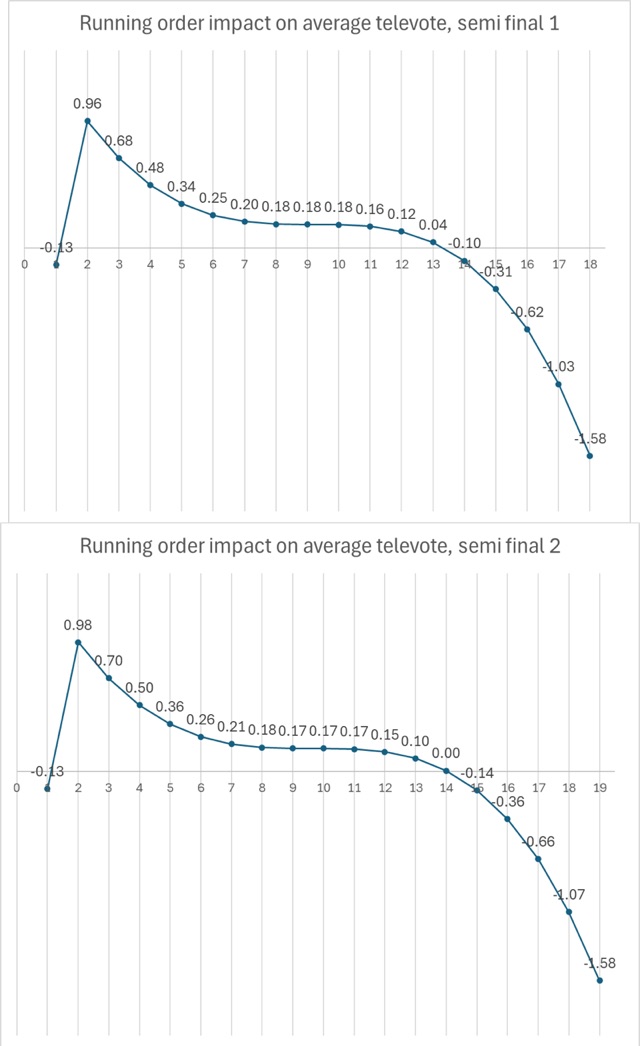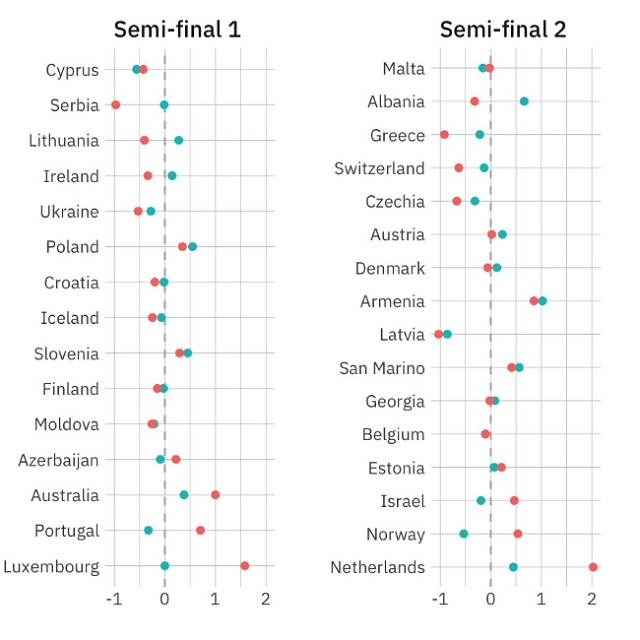The Facts Of The Draw
On Tuesday March 26th the running order for the Semi Finals of the 2024 Eurovision Song Contest were revealed. We now know that Silia Kapsis, the youngest entrant in the competition representing Cyprus, will open the competitive side of the Song Contest. Following her on Tuesday May 7th and Thursday May 9th will be each of the other competing acts at Eurovision 2024 will be on stage singing to impress the continent and beyond.
Constraints were put on this running order from the Allocation Draw in January, which had already decided in which Semi Final, and which half of each Semi Final, each song would perform. The running order was produced by SVT by Contest Producer Christer Björkman and subsequently approved by the EBU.
New for this year is the fact that the Big 5 entries and host country Sweden will perform live during the Semi Finals. They have been giving running order slots in and around the other competing acts performing in each show.
The Big Winners of the Draw
Eurovision folklore tells us that drawing last is good and drawing 2nd is bad. However this folklore has a large dose of reality medicine to go alongside it. Analysis of Eurovision Semi Finals from 2014 to 2023 by dolphin_dane has revealed that the folklore is accurate, with a running order position of 2nd giving you on average a start 2.5 places behind the song drawn in last position.

Calculations by Dolphin_Dane, based on Semi Final results from 2014-23. Results are adjusted for performance in the final, to filter out producer bias. The lower the number, the better.
Of course at this stage we know not just the running order of the songs, but also which countries compete and therefore vote in each Semi Final. We can combine the analysis above to the analysis of previous voting patterns to see the true winners from this Semi Final draw.

Analysis following the reveal of the 2024 Eurovision Semi Final running order. Blue dots give weighting from previous voting results from these countries, and pink colours combine these weightings with dolphin_dane’s running order historical analysis (Graphic: Mark Taylor, ESC Insight)
Luxembourg looks to be the big winner now from Semi Final One thanks to that late draw, though note here that their voting rating has been given as 0.00 as no previous televote data exists. The other winners include Portugal, which we would expect would also place highly from Luxembourg thanks to a large diaspora there making up 14.5% of their population, and Australia. Australia are helped in this Semi Final not only by the late draw but also by nations like Ireland, Sweden and the United Kingdom all voting in this show.
Should both Australia and Portugal be on the borderline to qualification then these effects from the should be enough to give them one extra ranking higher in the race to reach the final compared to if those nations were drawn in the middle of the show with a random set of fellow competitors.
This draw has been most kind of all those to Joost, with an expected finishing position for The Netherlands now two places higher in the Semi Final than one would expect from a random draw and country allocation. Note too how Armenia, placed 8th of 8 in the first half of the Second Semi Final, appears to be the country next in line to do better thanks to the draw results, with significant other nations in this Semi Final like France, Belgium, Georgia and The Netherlands where Armenia would be expected to score well from televoting.
The Storyline Of The Songs
Christer Björkman has described this year’s selection as being “playful with high energy” amongst the competing songs, whetting our appetite for the show by telling us “all participating countries have great ideas” for their staging.
While the songs might be playful, this running order feels very business-like. Remember that Christer Björkman was one of many championing the wish to introduce a producer led running order to Eurovision the last time we were in Malmö, and this running order feels more 2013 in style than 2024.
This running order follows on the whole the trends that we have come to know all too well in the past decade of the Song Contest. We start with a safe up-tempo bop, bring down the tempo a touch for song two, and kick things off again from there. We can see the core formula that was developed by the Melodifestivalen team over many years. In modern days we have spoken about how song two has been used for placing songs that will do well in other ways than their scoreboard position, considering how well communicated it has been as the worst competitive position in any running order.
The show also jolts around genres faster than you can ‘Rim Tim Tagi Dim’ as it offers one of the most sawtooth production patterns we have ever seen. There will likely just be forty-five seconds for viewers to adjust from Slovenia into Finland, Lithuania into Ireland or Armenia into Latvia.
At first glance we don’t see any of the songs this year running back-to-back bringing the same style of performance package onto the Eurovision stage. At a push I can comment on the opening run of Malta to Albania to Greece in Semi Final Two as all featuring powerful female performers giving their all on stage, but musically these numbers are so far away from each other there is little to connect for the viewers. I can’t remember a producer-made sawtooth in contrast as large as this before.
What should be said is that the feel of this show is particularly seen through the mindset of the Swedish view of Eurovision. This shifts the mindset of the competition further to the West, with all three songs closing both Semi Finals clearly Western in origin or musical style. Ignoring our palette setting starter, our songs in 2nd and 3rd are from Serbia, Albania, Lithuania and Greece, and come with sounds that clearly hail from their regions beyond Western Europe.
The Ides Of Disruption
The biggest disruption to this year’s Eurovision Song Contest is the inclusion of the Big 5 and Sweden—the Automatic Qualifiers to the Grand Final on Saturday night—into the running order of the Semi Final. You cannot vote for them on Tuesday or Thursday night (but you may be charged if you try), but they are taking up running time, changing the flow of the music, and impacting the audience’s emotions.
It’s worth noting that the placement of each performance is entirely at the whim of the production staff. While ‘out of competition,’ their placement can colour the chances of the songs around them.
While there are some concerns about the scripting to explain that “you cannot vote for the next song” followed by “okay you can vote again” taking place three times during each show, the roughly equal spacing of the entries suggests how the evening will be presented.
In essence, the show features four performative acts, which are broken up by a combination of the automatic qualifiers and commercial breaks which, for the majority of viewers, are an extended chat in the green room or a typically whimsical piece of Swedish humour.
If you’re looking for our opinion, it makes more narrative sense to end each section with an automatic qualifier and lead into a commercial break, giving viewers more time to be reminded they can vote again in the upcoming act.
The conundrum for now until May is how this integration impacts on the viewer. Christer Björkman says that by fully integrating these automatic qualifiers into these shows it will give them “the chance to grow into the Grand Final”. The position to grow is there, but the impact of these songs on the competition that they are not involved in yet is an unknown factor. Should these songs be the crescendo of each section there could be something in the Big 5 stealing the limelight away from Europe’s smaller broadcasters in the quest for Eurovision week hype around your entry.
One of the curiosities around the four-act structure we see in the twin running orders is the end of the final act. Rather than one of the automatic qualifiers, Semi Final One closes with Luxembourg and Semi Final Two with The Netherlands. Over the last hour and a half, the viewers at home will have felt the excitement rise for the end of each section with a performance that is bigger than the Semi Finalists?
Are Tali and Joost going to be seen as the big tentpole songs, even more than usual, because of this? Statistically we know the significance that drawing last in the Semi Final already offers… but there is an emotional significance too, and it will be heightened this year more than any other.
One thing is for sure; Björkman and the production team know the staging and final studio cuts of the two closers are; every delegation’s staging plans were submitted in early March. There’s a reason why these two songs are being held up as the Big Damn Heroes of the night…
Final Thoughts
We can write about the obvious statistical points about number two being bad or last being good, but all songs good enough to win the Eurovision Song Contest will qualify from any running order position in the Semi Finals. In the grand scheme of things it is unlikely for any of this running order to alter more than one or two of the qualifiers that make it to Eurovision’s Saturday night showcase.
Nevertheless, announcing the running order is one of our rituals that makes Eurovision special. It offers us a starting grid for the competitive performances that are part of the fabric of our Song Contest, but it also helps shape the emotion and the energy of the Song Contest.
This year’s show feels like a very familiar version of our Eurovision Song Contest. The poptastic openers that settle you into a rhythm before the show twists and turns its way through its jagged changes before ending with anticipation is exactly what you expect when the songs are in Swedish hands.
Now we know the final moments we’re going to make in May, we can get excited about the latest journey.










The “disruption” caused by shoehorning in three non-scoring songs will make it harder to earlier songs to qualify. Simply because the memory of them will be even more distant when semi televoting time comes around. If I am right then there will be unexpected non-qualifiers from draws 1-2-3-4.